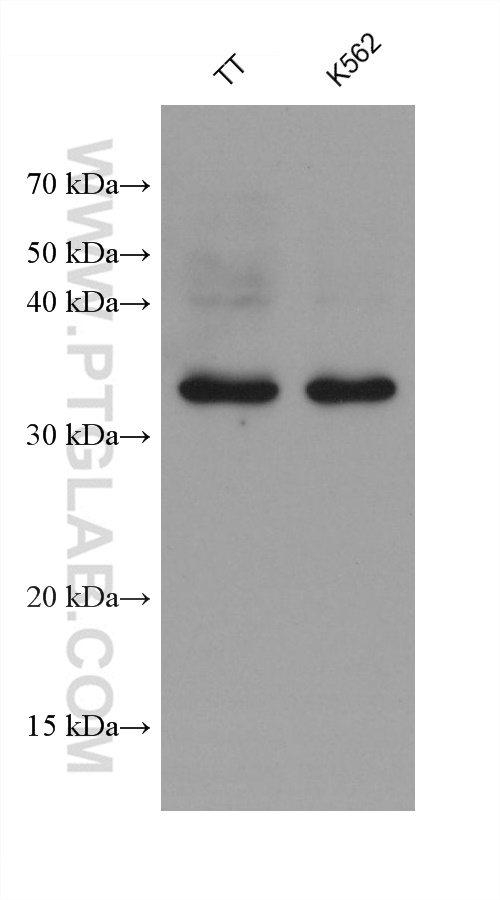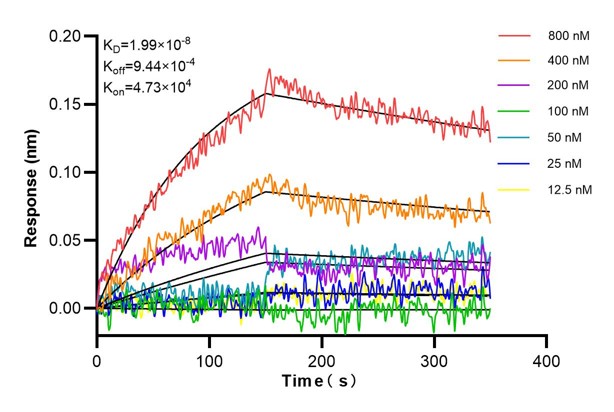验证数据展示
经过测试的应用
| Positive WB detected in | TT cells, K-562 cells |
推荐稀释比
| 应用 | 推荐稀释比 |
|---|---|
| Western Blot (WB) | WB : 1:2000-1:10000 |
| It is recommended that this reagent should be titrated in each testing system to obtain optimal results. | |
| Sample-dependent, Check data in validation data gallery. | |
产品信息
68981-3-Ig targets LAPTM4B in WB, ELISA applications and shows reactivity with human samples.
| 经测试应用 | WB, ELISA Application Description |
| 经测试反应性 | human |
| 免疫原 |
CatNo: Ag38696 Product name: Recombinant human LAPTM4B protein Source: e coli.-derived, PET28a Tag: 6*His Domain: 1-139 aa of BC014129 Sequence: MKMVAPWTRFYSNSCCLCCHVRTGTILLGVWYLIINAVVLLILLSALADPDQYNFSSSELGGDFEFMDDANMCIAIAISLLMILICAMATYGAYKQRAAWIIPFFCYQIFDFALNMLVAITVLIYPNSIQEYIRQLPPN 种属同源性预测 |
| 宿主/亚型 | Mouse / IgG1 |
| 抗体类别 | Monoclonal |
| 产品类型 | Antibody |
| 全称 | lysosomal protein transmembrane 4 beta |
| 别名 | 2A11H6, LAPTM4beta, Lysosomal-associated transmembrane protein 4B, Lysosome-associated transmembrane protein 4-beta, PSEC0001 |
| 计算分子量 | 41 kDa |
| 观测分子量 | 35 kDa |
| GenBank蛋白编号 | BC014129 |
| 基因名称 | LAPTM4B |
| Gene ID (NCBI) | 55353 |
| 偶联类型 | Unconjugated |
| 形式 | Liquid |
| 纯化方式 | Protein G purification |
| UNIPROT ID | Q86VI4 |
| 储存缓冲液 | PBS with 0.02% sodium azide and 50% glycerol, pH 7.3. |
| 储存条件 | Store at -20°C. Stable for one year after shipment. Aliquoting is unnecessary for -20oC storage. |
背景介绍
LAPTM4B, a novel oncoprotein, is associated with the prognosis of cancer, and may play important roles in the initiation, promotion and metastasis of tumors. It was initially identified as a hepatocellular carcinoma-associated gene, and was recently shown to be up-regulated in various human cancers. Some studies indicated that LAPTM4B may be an useful marker of prognosis in ovarian carcinoma and endometrial cancer. LAPTM4B belongs to the LAPTM4/LAPTM5 transporter family. It has 3 isoforms with molecular masses 41 kDa, 35 kDa and 24 kDa.
实验方案
| Product Specific Protocols | |
|---|---|
| WB protocol for LAPTM4B antibody 68981-3-Ig | Download protocol |
| Standard Protocols | |
|---|---|
| Click here to view our Standard Protocols |



